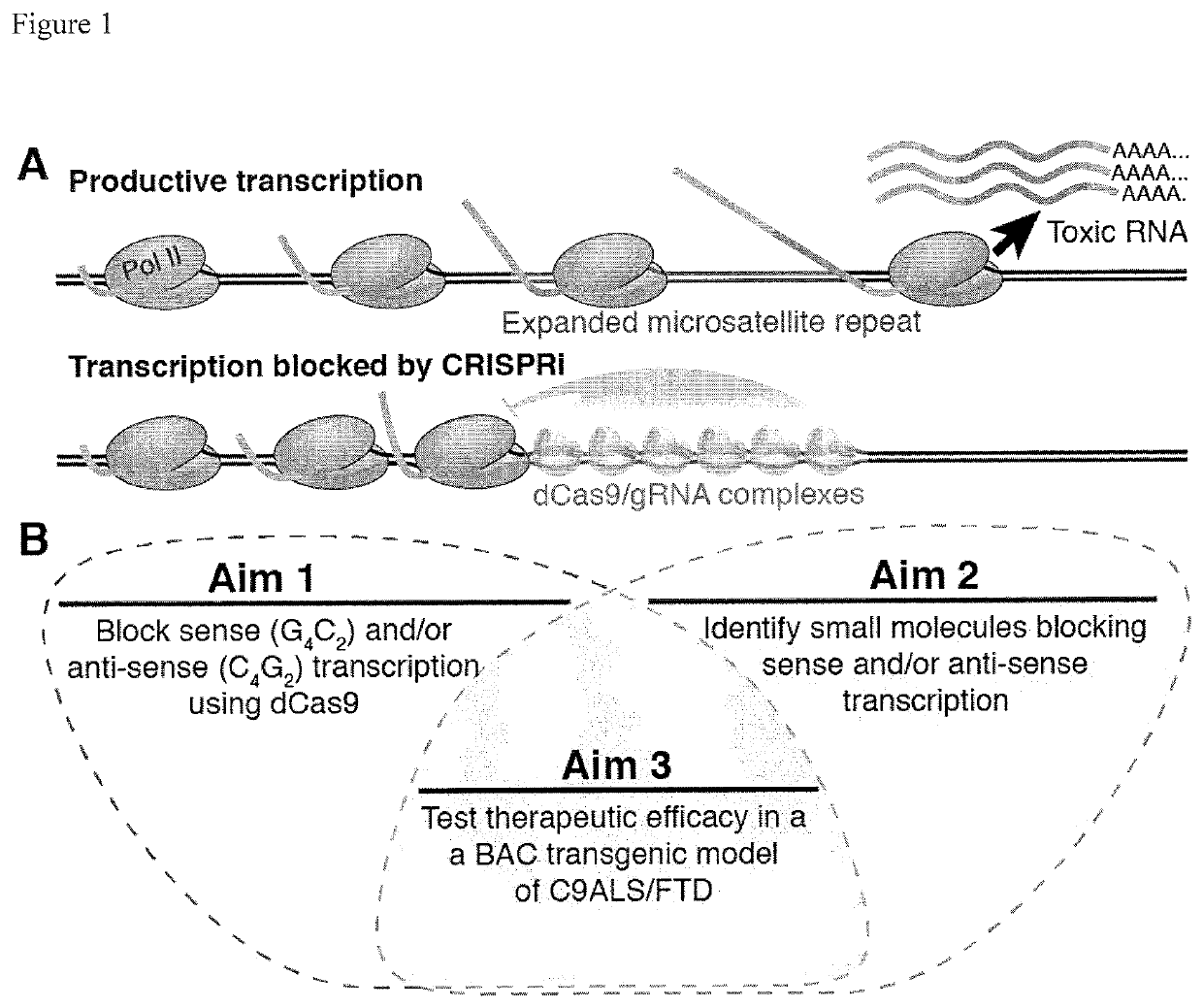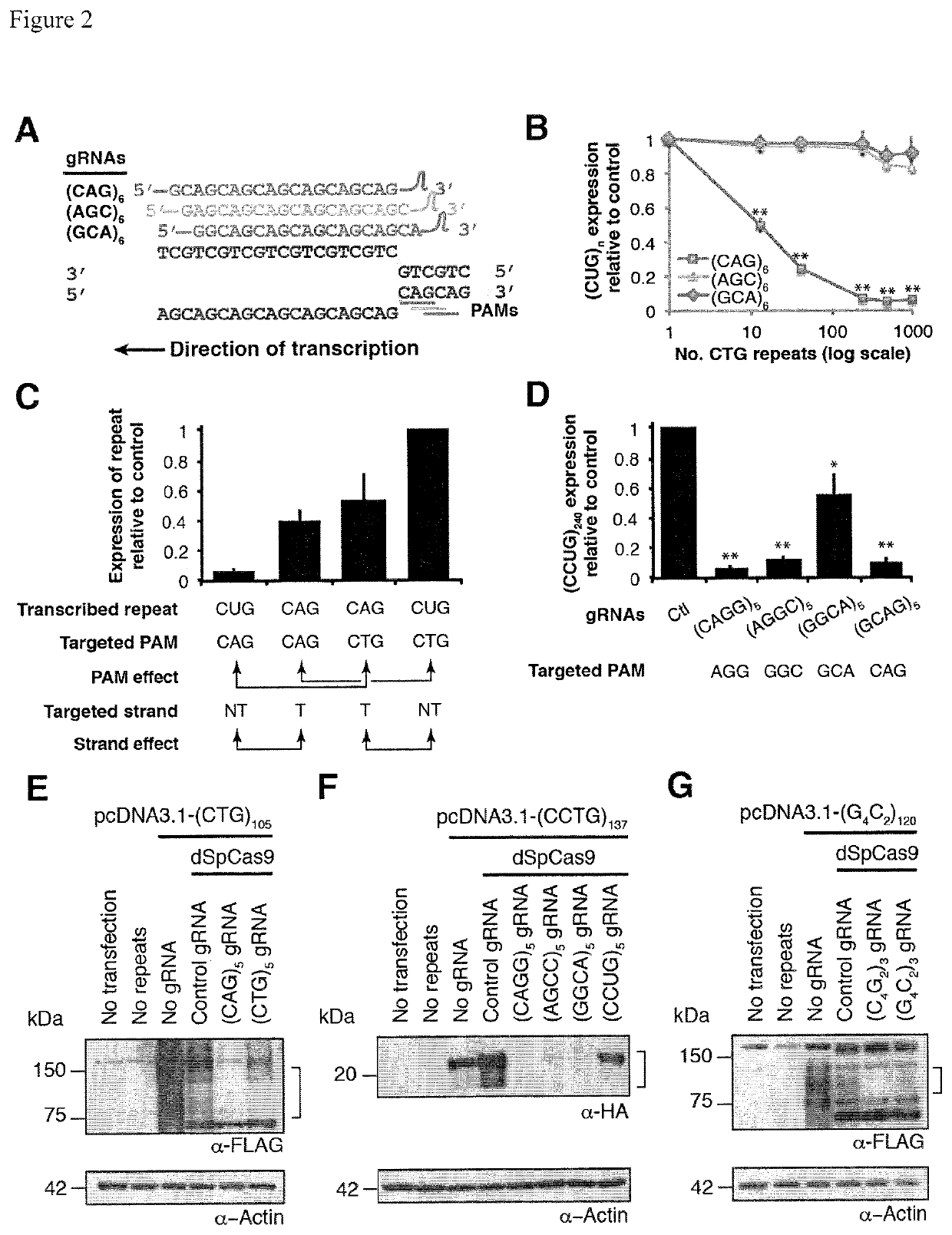Compositions and methods for impeding transcription of expanded microsatellite repeats
a technology of expanded microsatellite repeats and compositions, applied in the direction of viruses/bacteriophages, muscular disorders, drug compositions, etc., can solve the problems of cellular toxicity in these diseases, paralysis, respiratory failure, premature termination and nascent transcript turnover, etc., to reduce pathological rna foci and decrease myotonia
- Summary
- Abstract
- Description
- Claims
- Application Information
AI Technical Summary
Benefits of technology
Problems solved by technology
Method used
Image
Examples
example 1
[0064]Catalytically deactivated Cas9 (dCas9) inhibits transcription of CTG and CCTG repeat-containing transcripts (CRISPRi). Deactivated Cas9 can inhibit transcription, but typically relies on steric blocking in bacteria or requires a KRAB domain to inhibit initiation in mammalian cells when targeted to promoters. Inhibition of elongating RNA Pol II in mammalian gene bodies showed ˜40% reduction at best. However, long repeats could recruit multiple dCas9 proteins using a single guide RNA (gRNA) sequence, resulting in enhanced steric blockade, consistent with the “CRISPRi collision model”, leading to paused RNAP and disassembly (FIG. 5A). To test this hypothesis, expression of mRNAs containing multiple CUG repeat lengths in the presence of control, CAG-targeting, or CTG-targeting gRNAs was measured. Three CTG-targeting gRNAs were tested, where the register of repeats relative to the PAM (CAG, AGC, and GCA) was shifted (FIG. 5B). A CAG-targeting gRNA was also tested. Consistent with S...
example 2
tal Model and Subject Details
Cell Lines
[0066]Human cell lines and primary cells were utilized in this study. Patient myoblast cell lines were derived from muscle biopsies under a University of Florida-approved IRB protocol with informed consent from all patients. Information on the genders of the patient cells is unavailable. All cells were grown under standard conditions of 37° C. and 5% CO2 in media supplemented with 10% fetal bovine serum.
Animals
[0067]In vivo animal studies were performed on HSALR transgenic mice in this study. Both males and females were used in EMG analysis, which was performed at 5 weeks of age, as by this time point mice display appreciable myotonia. All these studies were performed in accordance with guidelines and regulations of the Institutional Animal Care and Use Committee (IACUC) at the University of Florida.
Method Details
Cell Culture, Cell Lines and Transfection
[0068]HeLa and HEK293T cells were cultured in 1×DMEM supplemented with 10% fetal bovine seru...
PUM
| Property | Measurement | Unit |
|---|---|---|
| temperature | aaaaa | aaaaa |
| length | aaaaa | aaaaa |
| stability | aaaaa | aaaaa |
Abstract
Description
Claims
Application Information
 Login to View More
Login to View More - R&D
- Intellectual Property
- Life Sciences
- Materials
- Tech Scout
- Unparalleled Data Quality
- Higher Quality Content
- 60% Fewer Hallucinations
Browse by: Latest US Patents, China's latest patents, Technical Efficacy Thesaurus, Application Domain, Technology Topic, Popular Technical Reports.
© 2025 PatSnap. All rights reserved.Legal|Privacy policy|Modern Slavery Act Transparency Statement|Sitemap|About US| Contact US: help@patsnap.com



